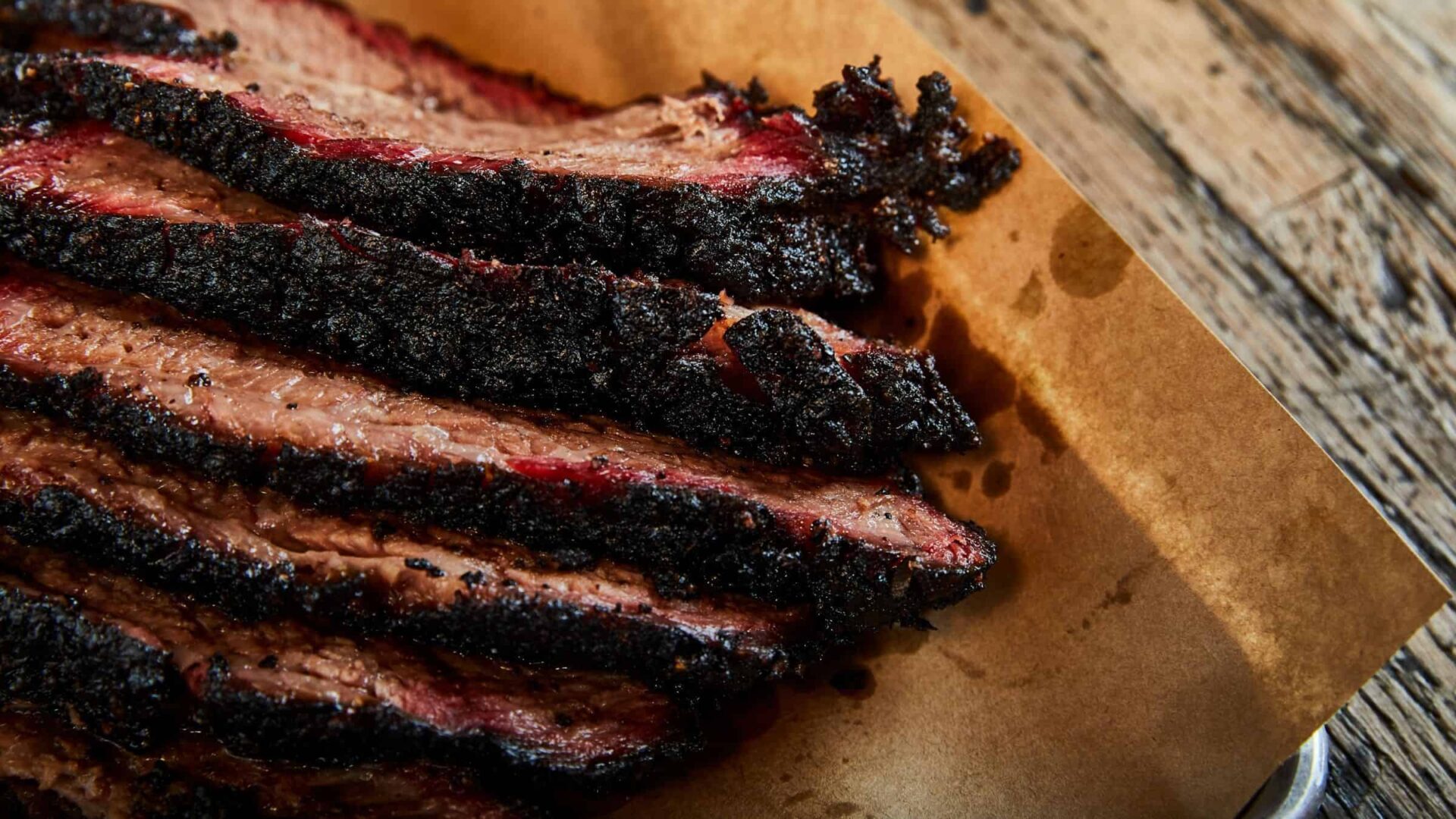As somebody who moved to Texas in 1999 (“I wasn't born here, but I got here as quick as I could”), I love Texas barbecue. That means, in particular, the “Texas Trinity” of brisket, sausage, and ribs — although ribs are my least favorite of those three. I love eating them, but ribs don't agree with me and my stomach for some reason.
Do I want my brisket “fatty” (or “moist”) instead of the “lean” end? This might surprise you, but I'll go for the non-lean option ANY time.
I do believe in the “standard work” of not putting sauce on your BBQ. If it's good enough, it has all the flavor it needs without sauce.
That's some great-looking “bark” on this brisket:

I've found good Texas-style BBQ in Los Angeles. That doesn't include the one place that claimed to be “Texas-style” — I was appalled when I picked up my to-go order and found that the meat had been doused (slathered?) in sauce. No. Just no. That's wrong. Sauce on the side, if at all.
I gave them that “voice of the customer” feedback and they shrugged it off. So, I haven't gone back.
Anyway, it's tough times for many BBQ joints — and tough times for many businesses — as raw material prices increase in inflationary times.
The raw material? Beef (sometimes pork, but Texas BBQ is mostly beef-based).
And there's probably pressure from increased labor costs that come from increased competition for employees.
I read this in the Wall Street Journal (the link should allow for free reading for all):
Don't Mess With Texas Barbecue: Restaurants Confront Rising Meat Prices
Many businesses, when faced with higher supply chain costs (or labor costs), try to pass that along to customers in the form of price increases. They often feel entitled to do so.
If you can raise prices, great. Will the market bear that? Raising prices might drive customers away, so that's the risk you take.
Better than raising prices (and this is an old lesson from Toyota) would be finding ways to reduce waste so you can offset that supply cost increase. I've written about this a lot before (but not recently).
The subheadline of the WSJ piece points to this:
Lone Star pitmasters get creative to stay afloat and keep a pillar of the state's culture alive
It's time for many businesses to get creative:
- Reducing waste
- Finding new ways to create value for customers
Some of the problem statements:
While restaurants of all kinds are feeling pinched by the rising costs, barbecue restaurants traffic in huge quantities of meat, typically sold by the pound, and often have few other offerings to offset price fluctuations. Texas barbecue is dominated by brisket, which many restaurant owners said has doubled in wholesale price over the past year or two.
Some restaurants, as the article explains, have added other offerings:
Bar / liquor sales — I know that Heim BBQ in Fort Worth, for example, sells great whiskeys at really low prices. I asked the bartender about this a few years back and he said, “We make our money on the meat, so we're happy to offer reasonable prices at our bar.” I wonder if there's pressure to raise those bourbon prices? I might have to go to the gemba.
New food items — tacos, more of a focus on side dishes, etc. “To bring in more revenue, [one BBQ joint owner] started relying more on combination plates, such as barbecue sandwiches or tacos with sides like potato salad or beans, and on nachos or other higher-margin products that incorporate some meat.”
To quote Homer Simpson, “Mmmmmm, collard greens with brisket…. mmmmm, green beans with brisket…”
The article also shares an example of reducing waste:
“[One restaurant owner] has gone to new lengths to keep any meat from going to waste. He's become less aggressive in trimming briskets, leaving more fat. What brisket fat he does trim, he mixes into burgers and sausages. He's shifted from cooking briskets in butcher paper, which leaks fat, to aluminum, which holds it in.”
As I said earlier, this customer is fine with eating the fat. Bring it on! It's not as bad for you as sugar.
He's using the fat trimmings and drippings instead of throwing them away.
As long as the waste reduction that's focused on cost doesn't affect quality.
The same restaurant owner said:
“I don't think it makes as good a brisket, but sometimes you've got to do what you've got to do,” Mr. Joseph said.
Oops. Maybe the brisket is still “good enough.” Maybe you don't need to be an award-winning brisket smoker… maybe you don't need to be near the top of the Texas Monthly Top 50 BBQ Joints list to have a profitable and sustainable business.
It's better to be creative. It's decidedly uncreative to just pass higher costs along to customers. It might also be a foolish thing to do, for the long-term.
What do you think? Please scroll down (or click) to post a comment. Or please share the post with your thoughts on LinkedIn – and follow me or connect with me there.
Did you like this post? Make sure you don't miss a post or podcast — Subscribe to get notified about posts via email daily or weekly.
Check out my latest book, The Mistakes That Make Us: Cultivating a Culture of Learning and Innovation:









